
Pehr Evind Svinhufvud af Qvalstad was the third president of Finland from 1931 to 1937. Serving as a lawyer, judge, and politician in the Russian Grand Duchy of Finland, he played a major role in the movement for Finnish independence, he was one who presented the Declaration of Independence to the Parliament. In 1917–1918, Svinhufvud was the first Head of State of independent Finland, first as Chairman of the Senate and subsequently as Protector of State or Regent. He also served as Prime Minister from 1930 to 1931.
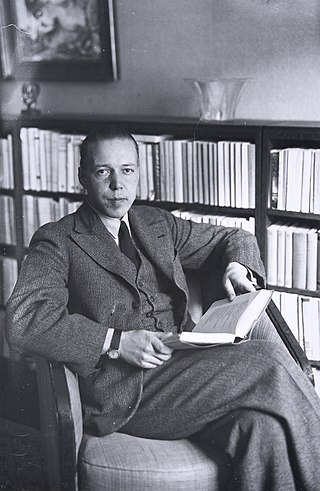
Mika Toimi Waltari was a Finnish writer, best known for his best-selling novel The Egyptian. He was extremely productive. Besides his novels he also wrote poetry, short stories, crime novels, plays, essays, travel stories, film scripts, and rhymed texts for comic strips by Asmo Alho.
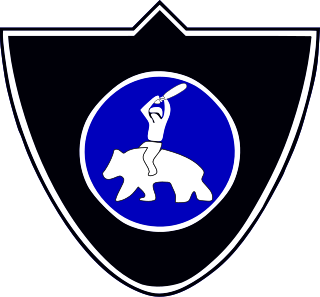
Patriotic People's Movement was a Finnish nationalist and anti-communist political party. IKL was the successor of the previously banned Lapua Movement. It existed from 1932 to 1944 and had an ideology similar to its predecessor, except that IKL participated in elections with limited success.
The Bank of Finland is the central bank of Finland and today the bank is a member of the European System of Central Banks. It views itself as the fourth oldest surviving central bank in the world, after Sweden's Riksbank, the Bank of England, and the Bank of France.

The Order of the Lion of Finland is one of three official orders in Finland, along with the Order of the Cross of Liberty and the Order of the White Rose of Finland. The President of Finland is the Grand Master of all three orders. The orders are administered by boards consisting of a chancellor, a vice-chancellor and at least four members. The orders of the White Rose of Finland and the Lion of Finland have a joint board. The President of Finland wears the Star of the Order of the Lion of Finland.
Capital punishment in Finland has been abolished de jure.
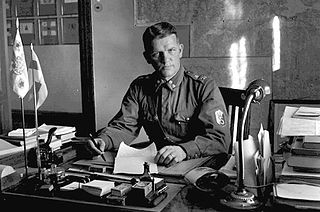
Aaro Olavi Pajari was a Major General in the Finnish Army. During World War II, he became one of the four double recipients of the Mannerheim Cross 2nd Class.

Erkki Aleksanteri Räikkönen was a Finnish nationalist leader.

Toivo Joel Rinne was a prolific Finnish actor of stage and screen. Among his most memorable film parts was the title role in the Inspector Palmu movie series, which started in 1960's Komisario Palmun erehdys, and continued in three sequels. Another well-known role in Joel Rinne is in the 1970 film Päämaja, directed by Matti Kassila, in which Rinne interprets in the role of Marshal Mannerheim.
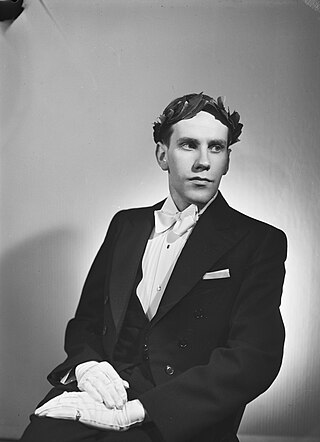
Jaakko Paavolainen, was a Finnish historian, PhD 1966. He became professor in history at the University of Turku 1986–1989.

The Finnish military administration in Eastern Karelia was an interim administrative system established in those areas of the Karelo-Finnish Soviet Socialist Republic (KFSSR) of the Soviet Union which were occupied by the Finnish army during the Continuation War. The military administration was set up on 15 July 1941 and it ended during the summer of 1944. The goal of the administration was to prepare the region for eventual annexation by Finland.

In Finland, the far right was strongest in 1920–1940 when the Academic Karelia Society, Lapua Movement, Patriotic People's Movement (IKL) and Export Peace operated in the country and had hundreds of thousands of members. In addition to these dominant far-right and fascist organizations, smaller Nazi parties operated as well.
The People's Community Society was a Finnish-Swedish Nazi organization from 1940 to 1944, founded at Söderkulla Manor in the autumn of 1940 in Söderkulla, Sipoo, Finland. Admiral Hjalmar von Bonsdorff was elected its first chairman and Lieutenant Gunnar Lindqvist its secretary. Sipoo was in the 1930-1940s a center of Finnish-Swedish nazism, as in addition to Bonsdorff, another central Finnish nazi figure Thorvald Oljemark owned manor there. Unto Boman, among others, was present at the inaugural meeting, who in 1941–1944 served as a liaison to the Finnish Waffen-SS volunteer battalion in Berlin. According to him, the idea of forming a battalion was first presented at a meeting of the board of the SF. Other activists of the organization included Pehr Norrmén, an industrialist and banker who was also involved in the recruitment of SS volunteers in the spring of 1941, and Barons Bertil von Alfthan and Torsten Aminoff.
Gunnar Isak Lindqvist was a Finnish Jäger and a senior lieutenant in the Estonian Army. He had received military training during the First World War as a Jäger and received his baptism of fire on the Eastern Front at Misse River in 1916. Later, he took part in the Finnish Civil War in the White Army as a signals officer and in the Estonian War of Independence as a battalion commander. During his life he served in the armies of three states and was a veteran of the six wars. In the 1930s and 1940s, Lindqvist took part in several Nazi groups.

Gunnar Emil von Hertzen was a Finnish Jaeger officer and the planner of the Aunus expedition (1919). He was a physician by profession and served as a physician during the Winter and Continuation Wars, becoming a lieutenant colonel in medical corps. He also took part in Nazi organisations in the 1930s and 1940s.
The Party of Finnish Labor was a Finnish far-right party operating in the 1930s and 1940s, led by engineer Niilo Rauvala. The party's motto was: "Finland into a great and rich nation state". In 1940s, the organization was known as the New Finnish Party. The party was dissolved on 18 January 1945 as contrary to Article 21 of the Moscow Armistice, which forbade fascist parties.
Niilo Vilho Rauvala was a Finnish engineer and the chairman of the far-right Lalli Alliance of Finland and the Nazi Party of Finnish Labor in the 1930s and 1940s.
The Patriotic Citizens of Viitasaari was an organization operating in Viitasaari in Central Finland. The association was one of the first prominent, explicitly anti-Semitic and anti-Masonic organizations in Finland. From 1928 to 1930, the group was run by Gunnar von Hertzen, a municipal physician.

Ajan Suunta was the newspaper of the Finnish Patriotic People's Movement (IKL) that ran from 1932 to 1944. IKL published thirty newspapers and magazines, but the daily newspaper Ajan Suunta was the main organ of the party. Ajan Suunta was preceded by the newspaper Ajan Sana published from 1930 to 1932.
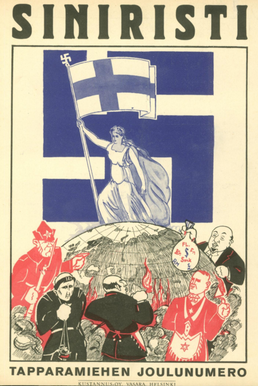
Siniristi was a Finnish Nazi magazine published between 1931 and 1939 and published by Publishing Company Oy Vasara that was operated by Gunnar von Hertzen and Y. W. Jalander. Its material consisted mainly of anti-Semitic propaganda adopted from Nazi Germany. The authors of the magazine included the well-known Finnish-Swedish Nazi Thorvald Oljemark.












